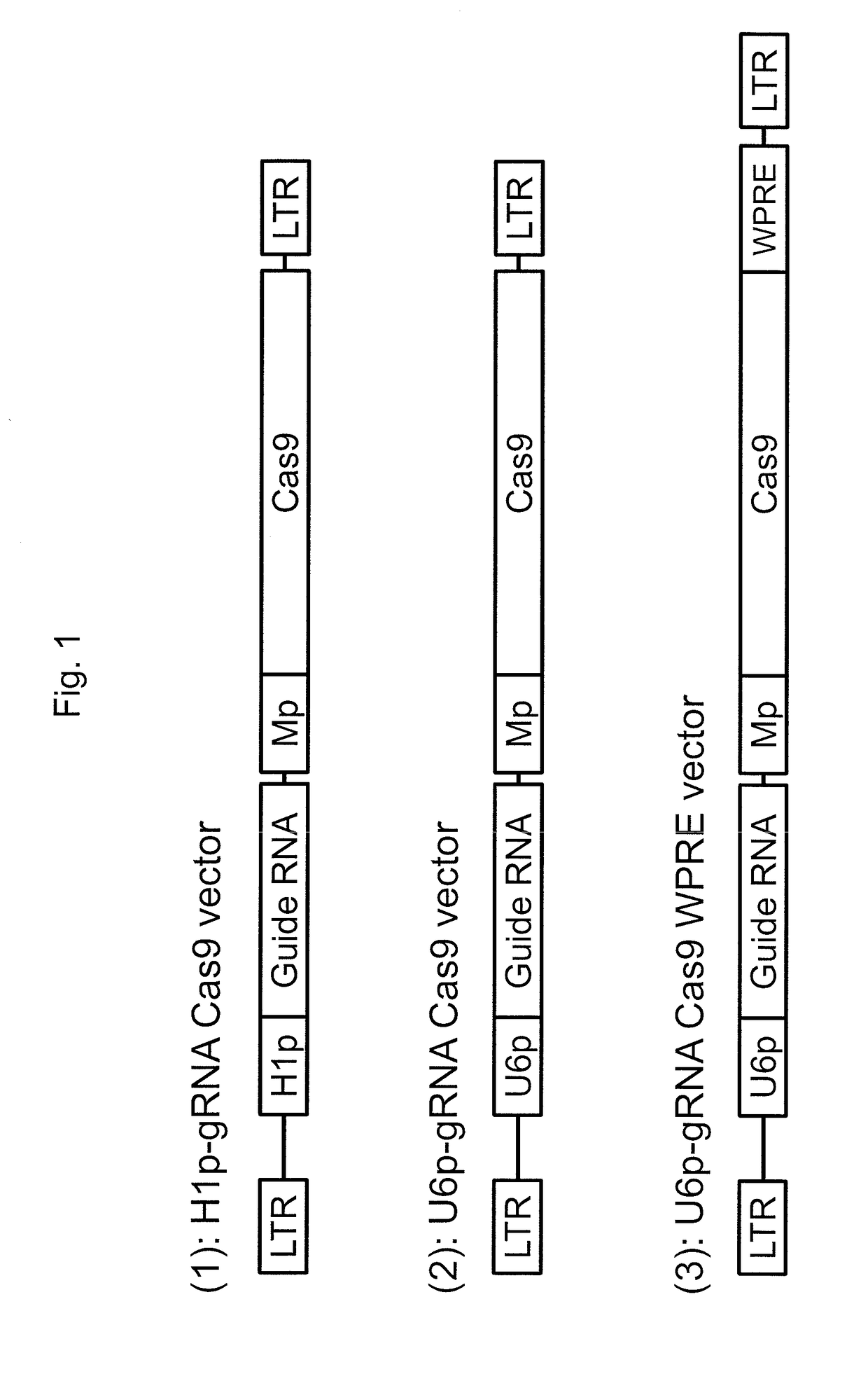Lentiviral protein delivery system for rna-guided genome editing
a technology of lentiviral protein and genome editing, which is applied in the direction of plasma/lacto globulins, peptides, enzymology, etc., can solve the problems of unpredictable off-target effects, limited precision, and time-consuming
- Summary
- Abstract
- Description
- Claims
- Application Information
AI Technical Summary
Benefits of technology
Problems solved by technology
Method used
Image
Examples
example 1
[0136]This example demonstrates the generation of a lentivirus vector system for delivering CRISPR / Cas9 elements to eukaryotic cells.
[0137]To deliver both guide RNA and Cas9 endonuclease into target cells, an HIV-1 based lentiviral vector system, SJ1 (Hanawa et al., Mol Ther., 5(3):242-51 (2002)), was used, which allows for efficient gene delivery in various cells, including hematopoietic stem cells and embryonic stem (ES) cells or induced pluripotent stem (iPS) cells. In this system, transgene expression cassettes can be integrated into genomic DNA in target cells, which allows for long-term transgene expression. Three types of lentiviral vectors were generated by co-transfection of Gag-Pol, Rev-Tat, vesicular stomatitis virus G glycoprotein envelope, and lentiviral vector plasmids, where each of the lentiviral plasmids encoded both guide RNA specific for green fluorescent protein (GFP) and Cas9 endonuclease. The H1 promoter or U6 promoter was used to control guide RNA expression i...
example 2
[0141]This example describes the generation of a lentivirus vector system in which the Cas9 protein is provided as a packaged fusion protein comprising a Cas9 endonuclease and a cyclophilin A (CypA) protein.
[0142]Cells transduced with the guide RNA / Cas9 system described in Example 1 continuously express Cas9 endonuclease even after completing site-specific DNA break and gene correction, which may result in DNA damage in target cells by off-target effects. In addition, the size of the Cas9 gene may be too large to ensure efficient lentiviral packaging in some cases, possibly resulting in reduced transduction efficiency in target cells. To address these issues, a fusion protein containing Cas9 and cyclophilin A was generated. The cyclophilin A (CypA) protein has been shown to bind to lentiviral capsids; thus, it was hypothesized that fusion proteins between Cas9 and CypA could be packaged in lentiviral particles.
[0143]Two Cas9 / CypA fusion proteins were designed: “CypA to Cas9” and “Ca...
example 3
[0145]This example describes the generation of an embodiment of the inventive lentivirus vector system in which the Cas9 protein is provided to a host cell.
[0146]A non-integrating lentivirus vector particle encoding both a GFP-targeting guide RNA and a YFP gene template (i.e., a donor nucleic acid molecule) was generated, and this vector contained all of the essential components for gene correction in a single vector (guide RNA, Cas9 protein, and template; see FIG. 7; sequence at SEQ ID NO: 13). Silent mutations in the target site of YFP template were required to produce the gene correction vector in order for the guide RNA to not target the YFP template. A GFP+HEL cell line was separately transduced with the lentiviral vector in combination with either a Cas9 / CypA fusion protein (described in Example 2) or the Cas9 protein itself as a control (the proteins packaged in the lentiviral vectors). Unexpectedly, a higher % YFP (29-30%, p<0.01) and lower % GFP (20-24%, p<0.01) was observe...
PUM
 Login to View More
Login to View More Abstract
Description
Claims
Application Information
 Login to View More
Login to View More - R&D
- Intellectual Property
- Life Sciences
- Materials
- Tech Scout
- Unparalleled Data Quality
- Higher Quality Content
- 60% Fewer Hallucinations
Browse by: Latest US Patents, China's latest patents, Technical Efficacy Thesaurus, Application Domain, Technology Topic, Popular Technical Reports.
© 2025 PatSnap. All rights reserved.Legal|Privacy policy|Modern Slavery Act Transparency Statement|Sitemap|About US| Contact US: help@patsnap.com



